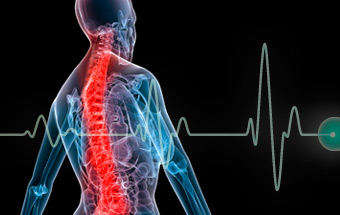Chiropractic Treatment of Sciatica
Pain is described as dull, achy, sharp, toothache-like, pins and
needles or similar to electric shocks. Other symptoms associated with
sciatica include burning, numbness and tingling sensations. Sciatica is
also called radiating or referred pain, neuropathy, or neuralgia. A
misconception is that sciatica is a disorder - however, sciatica is
really a symptom of a disorder.
Caused by Nerve Compression
Sciatica is generally caused by sciatic nerve compression. Disorders known to cause sciatic nerve pain include lumbar spine subluxations (misaligned vertebral body/ies), herniated or bulging discs (slipped discs), pregnancy and childbirth, tumors, and non-spinal disorders such as diabetes, constipation, or sitting on one's back pocket wallet. One common cause of sciatica is Piriformis Syndrome. Piriformis syndrome is named after the piriformis muscle. The piriformis muscle is located in the lower part of the spine, connects to the thighbone, and assists in hip rotation. The sciatic nerve runs beneath the piriformis muscle. This muscle is susceptible to injury from a slip and fall, hip arthritis, or a difference in leg length. Such situations can cause cramping and spasm to develop in the piriformis muscle, thereby pinching the sciatic nerve and causing inflammation and pain. Sciatic nerve compression may result in the loss of feeling (sensory loss), paralysis of a single limb or group of muscles (monoplegia), and insomnia.
Proper Diagnosis
Since there are many disorders that cause sciatica, the chiropractor's first step is to determine what is causing the patient's sciatica. Forming a diagnosis involves a thoughtful review the patient's medical history, and a physical and neurological examination. Diagnostic testing includes an x-ray, MRI, CT scan and/or electrodiagnostic tests (nerve conduction velocity, electromyography). These examinations and tests help to detect possible contraindications to spinal adjustments and other chiropractic therapies.
Treatment Approach
The purpose of chiropractic treatment is to help the body's potential to heal itself. It is based on the scientific principle that restricted spinal movement leads to pain and reduced function and performance. Chiropractic care is non-invasive (non-surgical) and drug-free. The type of treatment provided depends on the cause of the patient's sciatica. A sciatica treatment plan may include several different treatments such as ice/cold therapies, ultrasound, TENS, and spinal adjustments - sometimes called manipulation.
1. Ice/Cold therapy reduces inflammation and helps to control sciatic pain.
2. Ultrasound is gentle heat created by sound waves that penetrates deep into tissues. Ultrasound increases circulation and helps to reduce muscle spasms, cramping, swelling, stiffness, and pain.
3. Electronic Muscle Stimulation (EMS) is used to mimic a muscle contraction. This method of treatment is normally used to reduce muscle spasm and to prevent muscle atrophy after an injury.
4. Adjustments (Spinal Manipulation) Manipulation frees restricted movement of the spine and helps to restore misaligned vertebral bodies to their proper position in the spinal column. Spinal adjustment helps to reduce nerve irritability responsible for causing inflammation, muscle spasm, pain, and other symptoms related to sciatica. While there may be tenderness in the area, the adjustment itself should not produce pain. Spinal manipulation is proven to be safe and effective.
Caused by Nerve Compression
Sciatica is generally caused by sciatic nerve compression. Disorders known to cause sciatic nerve pain include lumbar spine subluxations (misaligned vertebral body/ies), herniated or bulging discs (slipped discs), pregnancy and childbirth, tumors, and non-spinal disorders such as diabetes, constipation, or sitting on one's back pocket wallet. One common cause of sciatica is Piriformis Syndrome. Piriformis syndrome is named after the piriformis muscle. The piriformis muscle is located in the lower part of the spine, connects to the thighbone, and assists in hip rotation. The sciatic nerve runs beneath the piriformis muscle. This muscle is susceptible to injury from a slip and fall, hip arthritis, or a difference in leg length. Such situations can cause cramping and spasm to develop in the piriformis muscle, thereby pinching the sciatic nerve and causing inflammation and pain. Sciatic nerve compression may result in the loss of feeling (sensory loss), paralysis of a single limb or group of muscles (monoplegia), and insomnia.
Proper Diagnosis
Since there are many disorders that cause sciatica, the chiropractor's first step is to determine what is causing the patient's sciatica. Forming a diagnosis involves a thoughtful review the patient's medical history, and a physical and neurological examination. Diagnostic testing includes an x-ray, MRI, CT scan and/or electrodiagnostic tests (nerve conduction velocity, electromyography). These examinations and tests help to detect possible contraindications to spinal adjustments and other chiropractic therapies.
Treatment Approach
The purpose of chiropractic treatment is to help the body's potential to heal itself. It is based on the scientific principle that restricted spinal movement leads to pain and reduced function and performance. Chiropractic care is non-invasive (non-surgical) and drug-free. The type of treatment provided depends on the cause of the patient's sciatica. A sciatica treatment plan may include several different treatments such as ice/cold therapies, ultrasound, TENS, and spinal adjustments - sometimes called manipulation.
1. Ice/Cold therapy reduces inflammation and helps to control sciatic pain.
2. Ultrasound is gentle heat created by sound waves that penetrates deep into tissues. Ultrasound increases circulation and helps to reduce muscle spasms, cramping, swelling, stiffness, and pain.
3. Electronic Muscle Stimulation (EMS) is used to mimic a muscle contraction. This method of treatment is normally used to reduce muscle spasm and to prevent muscle atrophy after an injury.
4. Adjustments (Spinal Manipulation) Manipulation frees restricted movement of the spine and helps to restore misaligned vertebral bodies to their proper position in the spinal column. Spinal adjustment helps to reduce nerve irritability responsible for causing inflammation, muscle spasm, pain, and other symptoms related to sciatica. While there may be tenderness in the area, the adjustment itself should not produce pain. Spinal manipulation is proven to be safe and effective.





